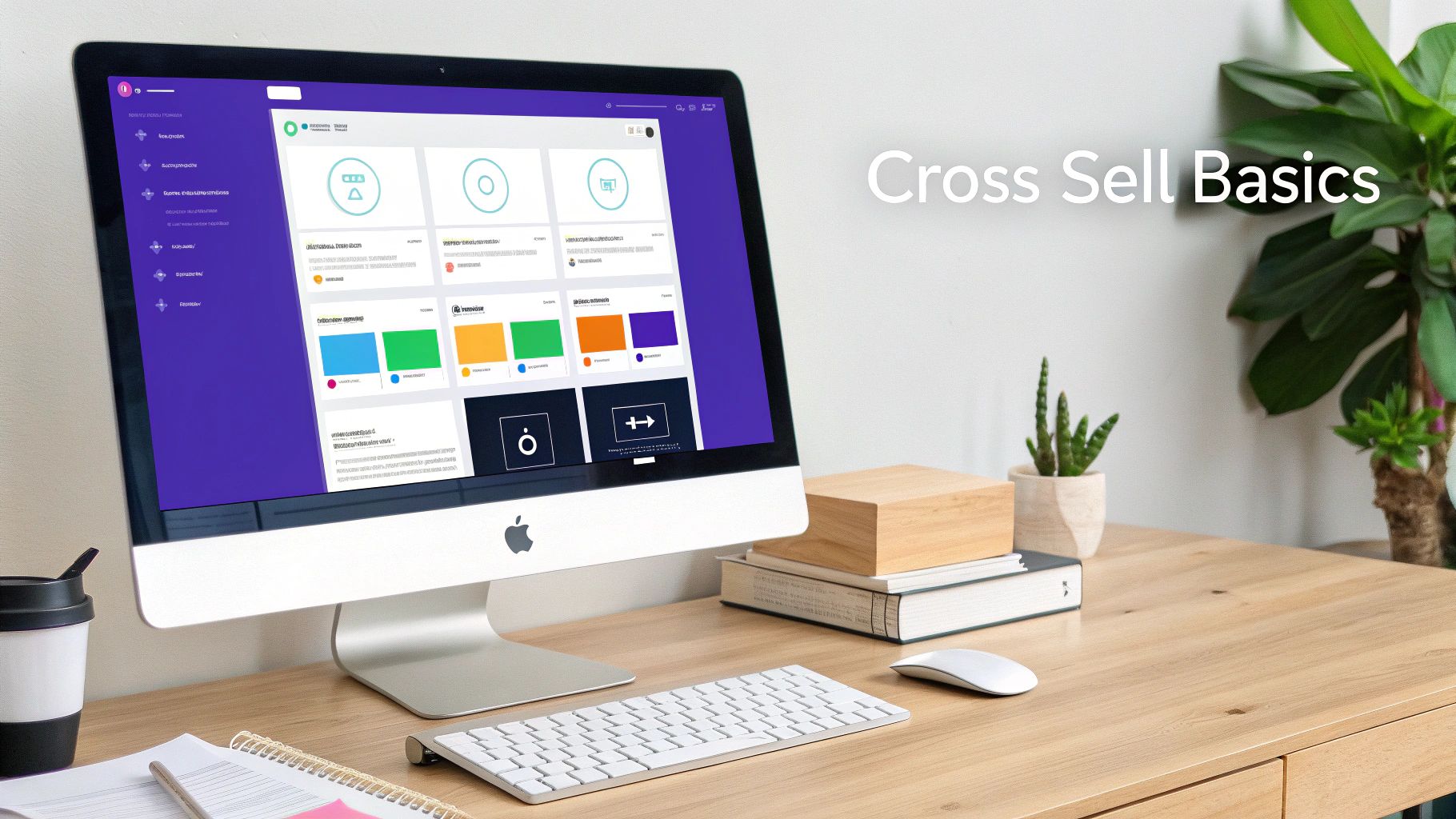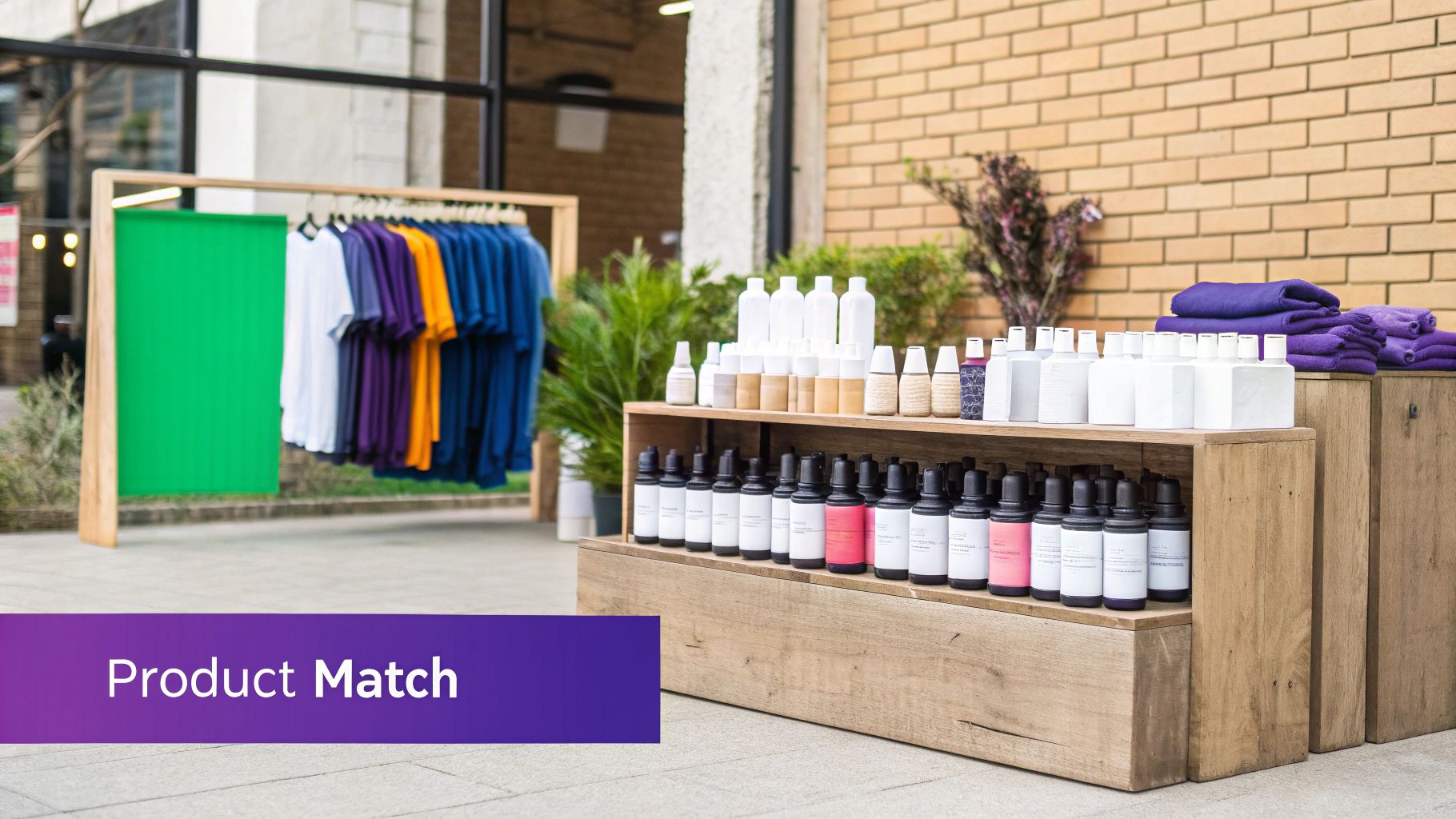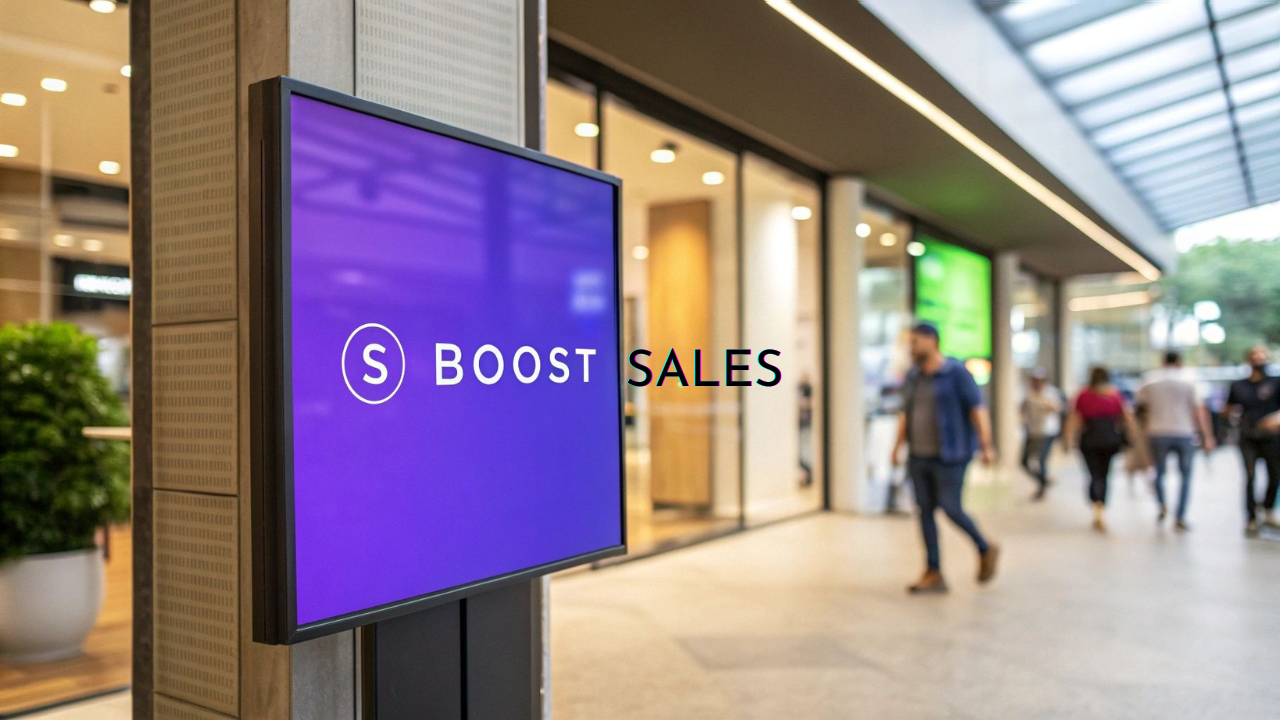The Psychology Behind Successful Cross-Selling on Shopify
Cross-selling on Shopify isn't just about suggesting more items. It's about understanding your customer's motivations. It's about offering products that complete a solution, enhance an experience, or maximize value. This is different from upselling, which encourages buying a pricier version of the same product.
Think of it this way: upselling is suggesting a larger coffee. Cross-selling is recommending pastries or syrups to go with it. This subtle distinction is key to framing your offers effectively.

Understanding the Customer Mindset
Customers respond better to cross-selling when it feels helpful, not pushy. This means offering genuinely complementary products that add value to their initial purchase. Suggesting a lens, memory card, or case to someone buying a camera makes sense. Suggesting a pair of shoes doesn't.
Timing matters, too. The right moment in the customer journey can dramatically impact conversions. Product page or checkout recommendations are far more effective than unrelated suggestions when a customer first arrives.
Leveraging Psychological Triggers
Several psychological principles can boost cross-selling effectiveness. Social proof, for instance, shows that others have found value in specific combinations. Phrases like "Frequently bought together" or "Customers who bought this also bought" tap into this principle.
Amazon is a master of cross-selling, with 35% of sales attributed to this strategy. Features like 'Customers who bought this item also bought' demonstrate its power. This success highlights the potential of cross-selling to improve sales figures. Find more detailed statistics here. Shopify merchants can significantly boost revenue with similar tactics.
Another powerful trigger is the desire for completeness. Product bundles or kits that offer a complete solution appeal to this. Selling a skincare set instead of just a cleanser is a good example. A small discount on bundled items further sweetens the deal, encouraging larger cart sizes.
Building Long-Term Relationships
Smart cross-selling can turn one-time buyers into loyal customers. Relevant and helpful recommendations build trust and show you understand their needs. This positive experience fosters repeat business and strengthens relationships.
This is especially crucial for Shopify stores building a brand community. Valuable product combinations reinforce this sense of community and belonging. Ultimately, successful cross-selling isn't just about bigger sales; it's about loyal customers and a better shopping experience.
Discovering Your Store's Hidden Cross-Selling Goldmines

Not all product pairings are created equal. Simply throwing random items together isn't a cross-selling strategy—it's a recipe for customer confusion. This section explores how successful Shopify merchants methodically identify truly profitable cross-selling opportunities, turning their stores into revenue-generating powerhouses.
Leveraging Shopify Data for Smarter Cross-Selling
Imagine a sales associate who anticipates your needs before you even speak. That's the potential of data-driven cross-selling on Shopify. Your store's analytics are a treasure trove of insights, revealing hidden product relationships and customer preferences you might otherwise miss.
This involves a deep dive into your Shopify data. Analyzing purchase history is key. For instance, if customers frequently buy hiking boots and trekking poles together, that’s a clear cross-selling opportunity. Looking at browsing behavior can also reveal products viewed in the same session, suggesting potential pairings.
Identifying cross-sell opportunities is vital. Analyzing customer demographics is another important aspect. Segmenting customers by age or location, for example, can highlight products that resonate with specific groups. Sales data analysis also pinpoints top performers and underperforming items. Pairing a bestseller with a complementary, less popular product can boost overall sales.
Tools like Airboxr provide insights into customer locations, order values, and frequently purchased items, making it easier to tailor cross-selling strategies. Learn more about identifying cross-sell opportunities. This data-driven approach ensures your cross-selling efforts align with actual customer behavior.
Strategic Product Segmentation: Finding the Perfect Pairs
Organizing your product catalog is just as important as the products themselves. Think of your product categories as departments in a well-organized store. Strategic segmentation groups related items, creating the foundation for logical cross-selling suggestions.
For example, an art supply store might segment its catalog into painting, drawing, and sculpting. This structure simplifies recommending complementary products within each category. Once segmented, identify cross-selling champions: products frequently bought together, boasting high average order values and positive reviews. These insights inform your cross-selling strategy and help create appealing product combinations.
Timing Is Everything: Presenting Offers at the Right Moment
Just like a well-timed joke, timing is everything in cross-selling. The right offer at the wrong time can feel intrusive and ineffective. Consider the customer journey. A customer browsing a product page is more open to a cross-sell than someone who just landed on your homepage.
The cart page is another key opportunity to suggest complementary items before checkout. However, avoid overwhelming customers with too many suggestions. A few relevant recommendations are more effective than a flood of unrelated products. The goal is to enhance, not disrupt, the customer experience. Strategic placement ensures your cross-sells are both visible and valuable.
Strategic Placement: Where Cross-Sells Convert Best

Successfully cross-selling on your Shopify store involves more than simply picking the right products. It's about presenting the right product at the opportune moment and in the ideal location. This strategic placement significantly impacts your conversion rates. This section explores the best locations for cross-sells in your Shopify store and how to optimize them.
Product Pages: Capitalizing on Initial Interest
Product pages are a powerful area for cross-selling. When a customer views a specific product, they show clear interest. This makes it the perfect time to suggest related items. For example, if someone is looking at a camera, you might recommend lenses, memory cards, or tripods.
Visuals are key. Showcasing these suggested items alongside the main product helps customers visualize the whole package. Don't overwhelm customers with too many choices. Instead, choose a few relevant cross-sells rather than a long list of unrelated products.
This focused approach creates a better user experience and maximizes your conversion potential. Explain the benefits of the additional item, highlighting how it enhances the main product. This encourages larger purchases.
Cart Pages: The Last Chance for Add-Ons
The cart page offers another valuable cross-selling opportunity. Before completing their purchase, customers are often open to last-minute additions, especially if they offer value. This stage is perfect for smaller, less expensive items that complement what's already in their cart.
Imagine a customer has added a dress to their cart. Suggesting matching jewelry or a handbag can increase the overall order value. Shopify provides a solid base for cross-selling. Using strategies like promoting cross-sells on product pages and offering incentives like free shipping can boost your conversions. Learn more about cross-selling on Shopify. This targeted approach, used by successful brands like Duradry, encourages additional purchases.
To help you understand the different placement options, let's look at a comparison table:
Effective Cross-Sell Placement Comparison This table compares different locations for cross-sell offers in your Shopify store, showing their effectiveness, implementation difficulty, and best practices.
| Placement Location | Average Conversion Rate | Implementation Difficulty | Best For | Key Considerations |
|---|---|---|---|---|
| Product Page | Medium-High (5-15%) | Easy | Complementary products | Limit choices, highlight benefits, use high-quality visuals |
| Cart Page | Medium (2-5%) | Easy | Lower-priced add-ons | Offer value, suggest related items, keep it concise |
| Post-Purchase (Thank You Page/Email) | Low-Medium (1-3%) | Medium | Consumables, refills, future purchases | Personalize recommendations, don't be pushy, offer incentives |
This table illustrates the various conversion rates and implementation difficulties associated with each placement strategy. While product pages generally have the highest conversion potential, each location plays a crucial role in maximizing cross-sell opportunities.
Post-Purchase: Extending the Relationship
The customer journey continues after checkout. Post-purchase cross-selling is a great way to build customer relationships and encourage repeat business. After an order is confirmed, a thank you page or follow-up email can suggest related products.
This works particularly well for consumable products or items needing refills. For example, if someone buys coffee beans, recommend a coffee grinder or filters. This generates additional revenue and strengthens customer loyalty. Personalized recommendations based on the initial purchase further improve the post-purchase experience.
Check out this article on how to master upselling on Shopify for more strategies to increase your average order value. By using these placement strategies, you can effectively implement cross-selling throughout the customer journey, maximizing sales and enhancing customer satisfaction.
Game-Changing Shopify Apps for Cross-Selling Excellence

Want to boost your Shopify store's revenue? Cross-selling is a powerful strategy. But managing it manually can be a real headache. Luckily, several Shopify apps can automate and optimize this process, freeing you to focus on other key areas of your business. Let's explore some game-changing apps that can elevate your cross-selling game.
Wiser: Personalized Recommendations with AI
Wiser uses artificial intelligence (AI) to deliver personalized product recommendations. It goes beyond simple "frequently bought together" suggestions. Wiser analyzes customer behavior, providing relevant and effective cross-sells. Features like post-purchase upsells and slide-cart recommendations offer multiple opportunities to increase your average order value (AOV). Wiser offers various pricing tiers, including a free option for smaller stores. Its compatibility with other Shopify apps enhances its integration and functionality.
Selleasy: Streamlined Upselling and Cross-Selling Made Easy
Selleasy provides a user-friendly interface for creating and managing upsell and cross-sell offers. Its flexible setup lets you display offers on multiple pages, including product, cart, and even thank you pages. This maximizes visibility and conversion potential. Selleasy also supports bundle offers and discounts, encouraging customers to buy more. Its simplicity makes it a great choice for merchants new to cross-selling or those seeking a streamlined solution. The "complete the look" recommendation feature helps customers visualize product pairings.
Bold Upsell: Customization and Proven Performance
Bold Upsell is a popular choice for its robust features and proven success. This app offers a high degree of customization, allowing you to tailor offers to specific products and customer segments. This targeted approach ensures the most relevant cross-sells are shown, maximizing conversion opportunities. You might be interested in: How to master selling courses on Shopify. Bold Upsell integrates seamlessly with your store's theme, maintaining a consistent brand experience. While a premium option, its powerful features make it a worthwhile investment for stores focused on optimizing cross-selling.
ReConvert Upsell & Cross Sell: Post-Purchase Powerhouse
ReConvert specializes in post-purchase upselling and cross-selling. This often-overlooked stage of the customer journey is a valuable opportunity to increase AOV. By presenting targeted offers on the thank you page, ReConvert capitalizes on the customer's buying momentum. This can significantly increase sales without disrupting the initial purchase. Features like order tracking and reorder buttons further enhance the customer experience and encourage repeat business.
Choosing the Right App for Your Shopify Store
The best cross-selling app depends on your specific needs and budget. Consider factors like your store's size, the complexity of your product catalog, and your marketing goals. Some apps excel at AI-driven personalization, while others prioritize ease of use and affordability.
To help you compare, here's a table summarizing the key features of the apps we discussed:
Top Shopify Cross-Selling Apps Comparison: A detailed comparison of the most effective Shopify apps for cross-selling, including pricing, features, ease of use, and customer ratings.
| App Name | Price Range | Key Features | Ease of Integration | Average Rating | Best For |
|---|---|---|---|---|---|
| Wiser | Free - $299/month | AI-powered personalization, post-purchase upsells, slide-cart recommendations | Easy | 4.9/5 | Stores of all sizes looking for personalized recommendations |
| Selleasy | $6.99 - $49.99/month | User-friendly interface, bundle offers, discounts, "complete the look" recommendations | Easy | 4.8/5 | Merchants new to cross-selling or seeking a simple solution |
| Bold Upsell | $9.99 - $49.99/month | Customizable offers, targeted product and customer segmentation, seamless theme integration | Moderate | 4.7/5 | Stores serious about optimizing cross-selling |
| ReConvert | Free - $14.99/month | Post-purchase upselling and cross-selling, order tracking, reorder buttons | Easy | 4.8/5 | Stores looking to maximize post-purchase revenue |
By carefully evaluating these factors and experimenting with different apps, you can find the perfect fit for your Shopify business and drive revenue growth.
Crafting Irresistible Product Bundles That Actually Sell
Product bundling is a powerful cross-selling strategy on Shopify. Many merchants, however, aren't taking full advantage of its potential. It's not about randomly grouping items together. Instead, the key is to create combinations that truly enhance the customer experience. Let's explore how to craft product bundles that convert casual browsers into enthusiastic buyers.
Identifying Natural Product Pairings
Understanding your customers' needs is the first step towards effective bundling. Successful Shopify stores analyze customer purchase history and browsing patterns to identify natural product affinities. For example, someone buying a camera might also need a memory card, a lens, and a carrying case. Bundling these related items provides a convenient, one-stop shopping solution.
This streamlined approach saves customers time and effort. It also positions your store as a helpful resource, fostering trust and encouraging repeat business. By anticipating needs and offering relevant bundles, you elevate the overall shopping experience.
Pricing Bundles for Perceived Value
Pricing is a critical factor in bundle success. The objective is to offer a perceived discount while maintaining healthy profit margins. A proven strategy is to calculate the total price of the individual items, then offer the bundle at a slightly reduced price. This creates a sense of value, motivating customers to choose the bundle over separate purchases.
For instance, if a camera costs $500, a memory card $50, and a carrying case $30, a bundle price of $550 represents a $30 discount. Even a small discount can significantly influence conversion rates, driving sales and increasing average order value. It presents the bundle as a wise purchasing decision.
Crafting Compelling Bundle Descriptions
Bundle descriptions should clearly communicate the value proposition. Highlight both the practical and emotional benefits. Explain how the bundled items work together to enhance the overall experience. Focus on the value they deliver as a combined package, rather than simply listing the individual items.
Consider the camera bundle example. A compelling description might emphasize the convenience of having everything needed to begin taking photos immediately. It might also underscore the cost savings compared to purchasing items separately. This approach resonates with customers by focusing on the benefits, not just the features.
Using Visuals to Showcase the Bundle Experience
Visuals are essential for conveying the value of your bundles. Use high-quality images and videos to showcase the bundled items together. This helps customers visualize the complete package and grasp how the products complement each other. For example, show the camera with the lens and memory card attached, neatly placed inside the carrying case.
This visual presentation enhances perceived value and makes the bundle more attractive. It allows customers to envision using the products, fostering a stronger emotional connection. Consider lifestyle images showcasing the bundle in use, adding another layer of appeal.
Creating Seasonal and Limited-Time Bundles
Creating a sense of urgency can further stimulate bundle sales. Seasonal or limited-time bundles are a particularly effective tactic. For example, a "Summer Photography Bundle" could include a camera, waterproof case, and extra battery, perfectly suited for summer vacation needs. Limited availability taps into the fear of missing out (FOMO), prompting immediate purchases.
This strategy works well for holidays or special events too. A "Holiday Gift Bundle" provides a convenient gift-giving option for shoppers. By aligning your bundles with specific occasions, you address timely customer needs and encourage impulse buys. This approach can substantially increase sales and generate excitement around your product offerings.
Measuring What Matters: Optimizing Your Cross-Sell ROI
Implementing cross-selling strategies on Shopify is just the first step. The real value comes from analyzing and refining your approach based on data. This section explores how to measure the effectiveness of your cross-selling initiatives and continually improve your return on investment (ROI).
Key Performance Indicators (KPIs) Beyond the Surface
While a general sales increase is positive, understanding the specific impact of cross-selling requires deeper metrics. Attachment rate, for example, measures how frequently cross-sells are added to orders. A high attachment rate suggests effective product pairings.
Another vital metric is the cross-sell conversion percentage. This tracks how often customers who view a cross-sell offer add it to their cart. This KPI reveals the effectiveness of your offer's presentation and messaging.
Tracking the true profit contribution of different product combinations helps pinpoint your most lucrative cross-sell strategies. This ensures your efforts maximize profit, not just sales volume.
A/B Testing: Refining Your Approach Through Experimentation
Effective cross-selling requires constant improvement. A/B testing offers a practical method to experiment with various approaches and measure their impact. You can test different product recommendations, visual presentations, or messaging.
This data-driven approach helps identify what works for your audience. For example, testing various product pairings on product pages can reveal which combinations have the highest conversion rates. Experimenting with different visuals, like lifestyle images versus product-only images, can show what drives more clicks. You might be interested in: Learn more about effective customer retention strategies. These tests offer valuable data, guiding you toward optimizing cross-selling effectiveness.
Balancing Data with Customer Feedback
Quantitative data is essential, but don't ignore qualitative insights from customers. Customer feedback offers valuable context that data alone can't provide. Pay attention to customer reviews, product questions, and support inquiries.
This information can uncover hidden opportunities or highlight improvement areas. For example, negative reviews about irrelevant cross-sell suggestions indicate a need for refinement. Positive feedback about helpful product pairings validates your strategy. Balancing data with customer feedback creates a comprehensive understanding of your cross-selling performance.
Building a Framework for Continuous Improvement
Effective cross-selling is an ongoing process. Create a framework for regularly reviewing your KPIs, analyzing A/B test results, and incorporating customer feedback. This ensures your strategy adapts to your business and customer needs.
Regularly checking your attachment rate, for instance, can identify declining performance early, prompting adjustments. Analyzing A/B test results informs future experiments, driving improvements. By establishing a system for continuous learning and optimization, you ensure your cross-selling strategy remains effective and profitable. This iterative process will help you refine your approach and maximize your cross-selling potential.
Ready to transform your Shopify store? Explore the power of Tevello and unlock new revenue streams. Discover Tevello and take your Shopify business to the next level!




